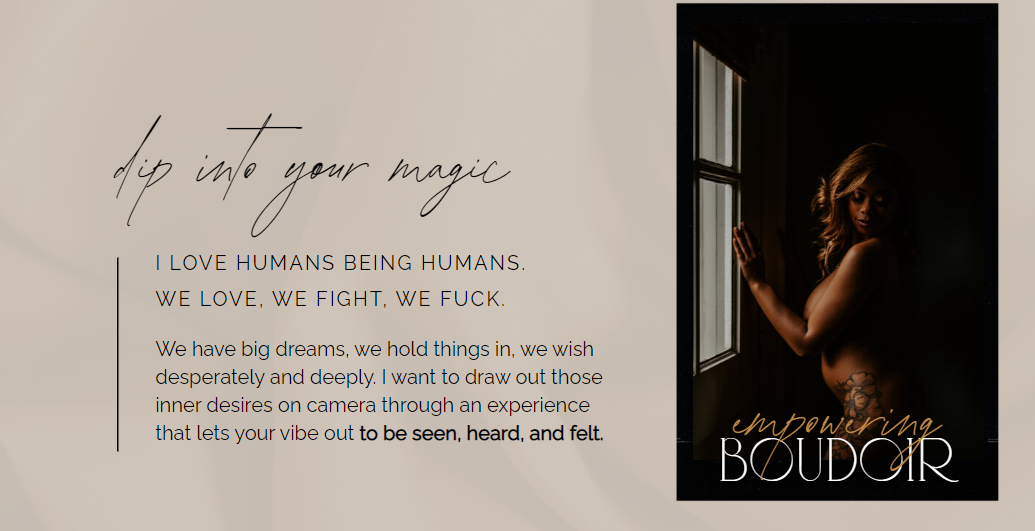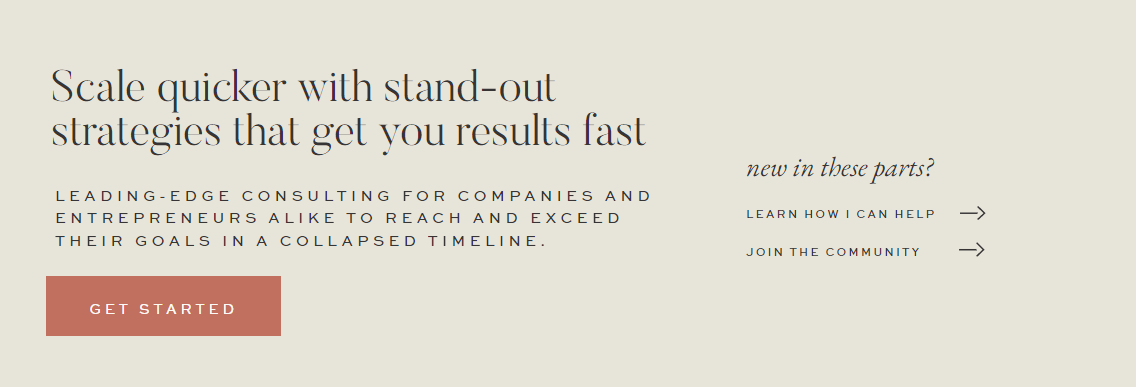10 Top Copywriting Tips for Beginners (With Examples)
If you’re starting your copywriting business journey, you might feel a little overwhelmed with all the copywriting information out there. Whether you’re a brand new writer or a business owner who wants to DIY their own copy, the amount of information on the internet covering “the best” copywriting techniques and strategies is A LOT. We get it.
Can you even teach yourself copywriting?
Absolutely! We’ll be the first to tell you that copywriting is a skill that anybody can learn. That is, anybody willing to learn and understand the copywriting best practices! 5+ years ago, Becca, founder and lead copywriter of BDCC was in the same position – and look how far she has come!
There is certainly a learning curve to copywriting, but once you know the ins and outs of what makes people take action and write copy that reflects this, you’ll be well on your way to becoming a professional copywriter in no time!
So if you’re ready to start writing great copy, want to touch up on your already budding copy skillset, or be able to tell the good copy from lousy copy (we’re looking at you, founders and CEOs), this post will break down the 10 best copywriting tips for beginners (with examples). Learn from us so you can start delivering amazing copy for your clients and build a thriving copywriting business today!
When you know the basics of copywriting, you’ll be able to whip up website copy, email funnels, ads, sales pages, and landing pages in no time!
Are you ready to learn how to write copy that sells? Let’s get to it!
-
Research, research, research!
Before you ever start writing copy, you absolutely need to do research. The most important part of copywriting is conducting the research…before you ever sit down to write the copy. You need to know your client, their offer, and their target audience. You also need to:
-
Understand your client. What is their business? What objectives are they trying to achieve? What is their vision, mission, and values?
-
Understand your client’s customers. What drives them? What type of persona are they? What’s in it for them? Why do they need your offer?
-
Understand the competition. What are they selling? How are they selling? How is the market responding to them? How are they different? How are they the same?
-
Understand the offer. What are the benefits? What are the features? How will it help people?
Do the necessary research to fully understand what you’re writing about and who you’re writing it to. It will make the actual writing part sooo much easier and so much more effective.
2. Keep things simple
The main idea behind copywriting is to move readers into action. One of the best ways to do this is by using simple, clear, and concise language. You might want to pack your copy full of intelligent words or clever lingo, but the less you use, the more powerful your writing becomes.
Using big, knowledgeable words might make you come across as smart, but if your reader doesn’t understand what you’re saying, it’s kind of pointless, right? If they need a dictionary to understand what you’re saying, they’ll quickly click off your page, and we don’t want that!!
Examples:


3. Use power words
Write powerful copy by using power words! Power words have the power to induce emotional responses (both positive and negative –so beware of how and when you use them). Power words can also help convince and persuade the reader to take aligned action.
Sounds like an easy copywriting tip, but it’s not as simple as you think! You want to sprinkle in just enough within your copy to enhance your reader’s emotion and move them into action, but no more! Remember, it’s easy to overdo it.
Example power words include: empower, captivate, intrigue, urgent, substantial, guarantee, instantly, and you (but there are so many more) and quick Google search will bring you so many power word bank options.
Examples:


4. Write catchy headlines
The headline is THE most important part of your entire copy because it captures the attention of your reader and helps them determine if they want to keep reading. According to a Copyblogger stat, 8 out of 10 people will ONLY read headlines, but only 2 out of 10 will read further than your headline. So headlines are a big deal.
A catchy headline is a part of any great copy strategy included on sales pages, email sequences, website copy, social media captions, ads — and any other piece of copy you can think of.
Here are a few tips for writing a catchy headline:
-
Keep it short and get straight to the point
-
Announce exciting news your audience will care about
-
Ask an intriguing question your audience wants answered
-
Highlight the main benefit
-
Tell your audience to take a specific action
-
Add symbols or numbers to catch their attention
We actually go into WAY more detail on how to write a catchy headline if you want to learn more. And a great tool that we love using for the headlines we write for our clients is the Coschedule Headline Analyzer Tool.
Examples:


5. Talk about the benefits
If you’re trying to sell a product or service you will always have features and benefits. But instead of focusing entirely on features, put all your effort into writing about the benefits.
Why? Because the benefits are what people buy. There is an age old saying, “Sell a good night’s sleep, not the mattress.” The benefit is a good night’s sleep. The features are the fabric blend, the number of coils, mattress size, etc.
When you write about the benefits, you are essentially painting a picture of how your customers will feel or experience once they use your product or service. Help them to imagine their life once they’ve moved through your offer. How do they feel? What emotions does your offer evoke?
Doing target market research (tip #1) will help you understand your reader’s pain points which will help you write about the benefits in a way that makes them want to invest in your offer.
To learn more about target audience pain points, check out our post about 12 Pain Point Questions to Ask for Market Research (coming soon!).
Examples:


6. Make it persuasive
Copy is meant to convince or persuade the reader to take action. But how do you use persuasive words without being sales-y?
First, you want to give the reader all the information they need to take action –without feeling pressured. Using too many coercing words or strong language can turn off your reader fast.
To avoid annoying, offending, or upsetting your reader, focus on using a few power words (from point #3) to evoke emotions and feelings from your reader.
You can also use copy strategies that will help you persuade your readers to take action like using social proof, becoming an authority or credible expert in your field, being consistent, giving constant value, using scarcity tactics (sparingly!), and building rapport with your readers.
These are all great ways to persuade and convince your reader to invest in an offer that is literally meant for them.
Examples:


7. Use formulas
To help steer your copy in the right direction, use proven formulas that work! Copywriting formulas tell you what to write, where to write it, and how to apply it to specific web pages.
Formulas are a go-to for most copywriters mainly because they are tested, shown to work, and can initiate your writing flow if you’re unsure what to say. We have a handful of go-to formulas, particularly for sales pages and website copy like home pages, about pages, and service pages. And we use them because they work!!
In fact, if you want to dive a little deeper, we have an in-depth blog post on the 2 formulas that will help you write your about page!
There are 5 basic formulas that every copywriter relies on:
-
AIDA – Attention, Interest, Desire, Action
-
PAS – Problem, Agitation, Solution
-
ACCA – Awareness, Comprehension, Conviction, Action
-
FAB – Features, Advantages, Benefits
-
The 4 P’s – Picture, Promise, Proof, Push
*If you want to read more details on some of these formulas, check out this Indeed post.
8. Create a swipe file folder
One of our favorite copywriting tips is to create a swipe file! As you browse through content online, there will be certain phrases or sentences that you love or spark your interest. Copy and paste them into a Google doc for you to refer to for inspiration as you write your (or your client’s) copy!
You can swipe headlines, taglines, paragraphs, or individual words that inspire creativity.
You can think of them as a library catalog for when you need help coming up with fresh content for your copy project or marketing campaign. Between your new swipe folder and your copywriting formulas (from Tip #7), you’re going to be well on your way to being an expert copywriter!
9. Outline your page or email
One of copywriters’ biggest pitfalls is losing sight of what they want to say. To help guide your copy and keep you from straying into irrelevance and overloading on fluff, create an outline or layout for your website copy, sales page copy, email funnels, social media posts, ads, or any other type of copy you’re writing.
Creating a structure for you to write within will help you get your point across efficiently with the least amount of effort. A win-win strategy if you ask us!
10. Never stop writing
Do we mean that you need to write 24 hours a day, 7 days a week? No. But the best way to improve your writing is by continuously writing. Like with any skill set, the more you practice, the better you get. So just start!
Remember, copywriting is a skill that takes time to master. But with these 10 best copywriting tips (that Becca and the BDCC team still use in every client copy project we take on), you’ll be a step ahead of the competition and well on your way to building a thriving copywriting business!
If you want more resources to start your copywriting business locked and loaded, check out the 10 best copywriting books for beginners, the best podcasts for copywriters, and the 5 best copywriting courses to get started.
Want help jumpstarting your copywriting business or need super helpful resources to help you write your own copy (because you’re just a DIY kind of gal)? Check out the BDCC shop, which is FULL of incredibly useful templates and copy bundles to help you write every type of copy you need to grow and scale a successful business –whether you’re a copywriter or a DIYer!
Shop our templates, outlines, questionnaires, and everything else you need to write your copy today! We also have a FREE sales page training freebie if you want to know exactly how Becca writes client sales page, with one generating over $500,000 for one client!